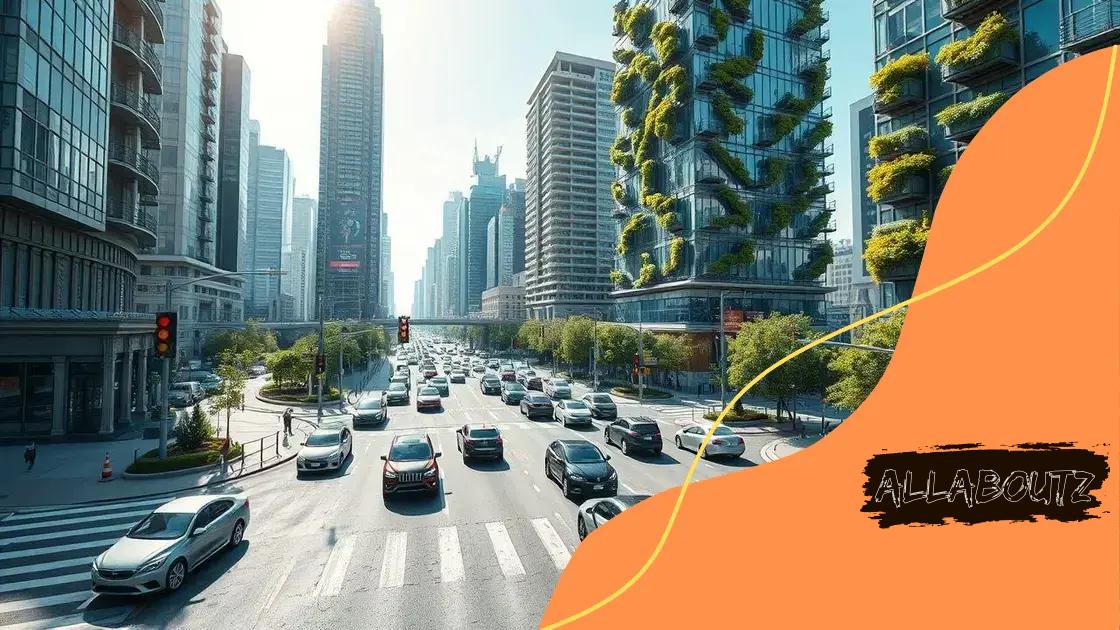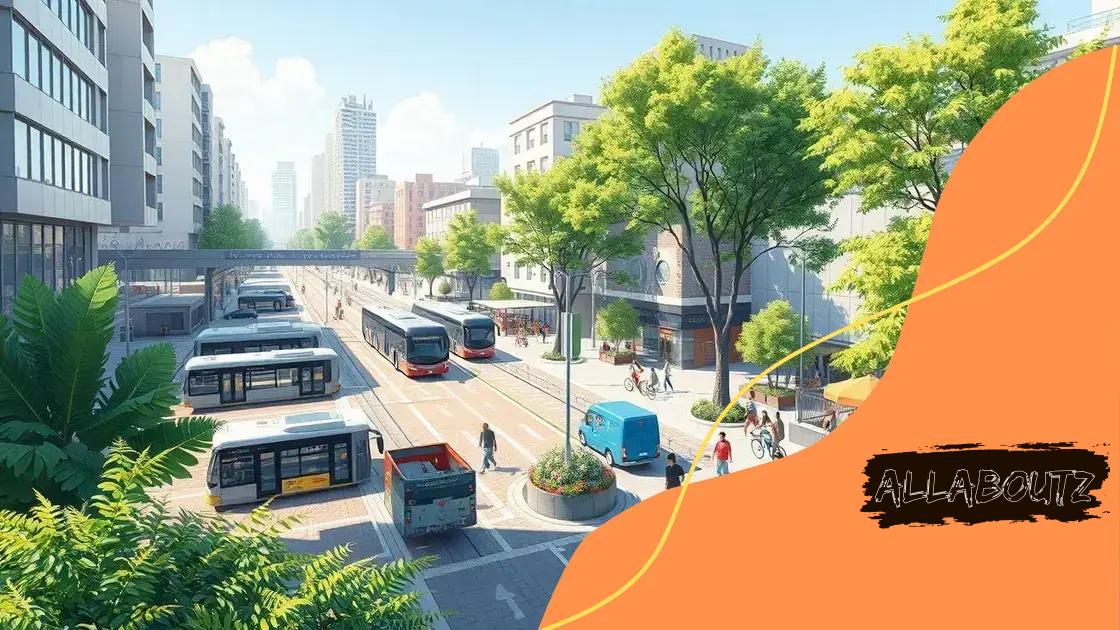Smart city projects driving urban innovation

Smart city projects leverage technology and data to improve urban living, enhance public services, and promote sustainability, as demonstrated by successful examples like Barcelona and Singapore.
Smart city projects driving urban innovation are not just buzzwords; they represent a shift in how we interact with our urban environments. Have you ever wondered how technology is transforming our cities for the better? Let’s dive into the details.
Exploring the concept of smart cities
When we talk about smart cities, we refer to urban areas that use technology to enhance the quality of life for their residents. These cities rely on digital solutions to improve services, reduce energy consumption, and increase efficiency.
Let’s break down the main aspects of smart city concepts.
Key components of smart cities
To create a truly smart urban environment, several factors need to come into play. Each of these components plays a crucial role:
- IoT (Internet of Things): Devices connect to the internet, collecting and sharing data to optimize services.
- Data analytics: Utilizing data to make informed decisions about urban planning and services.
- Renewable energy: Integrating sustainable energy sources to power city infrastructure.
- Mobility solutions: Smart transportation systems improve traffic flow and reduce congestion.
These elements work together to create a thriving environment for residents. By leveraging technology, cities can respond to challenges thoughtfully and sustainably.
Benefits of smart city concepts
Understanding the advantages of smart cities is essential for communities considering modernization. Some prominent benefits include:
- Improved public safety through enhanced surveillance systems and real-time data.
- Increased accessibility for all citizens, ensuring everyone can benefit from city services.
- Reduced environmental impact owing to efficiency measures and sustainability initiatives.
- Better quality of life through access to real-time information and smart services.
By focusing on these areas, smart cities can create a more engaging experience for inhabitants, encouraging community involvement and innovation.
Overall, the concept of smart cities revolves around enhancing urban living. When technology meets urban planning, the potential for sustainable development and enriched life is remarkable.
Key technologies powering smart city projects
Various key technologies are at the heart of smart city projects, driving innovation and enhancing urban environments. Understanding these technologies is essential for recognizing how they improve city life.
Internet of Things (IoT)
The IoT connects devices and sensors across the city. This network allows for the collection and analysis of data in real-time, enabling cities to respond quickly to environmental changes.
This connectivity leads to better resource management, such as:
- Smart streetlights: Automatically adjusting brightness based on pedestrian movement.
- Waste management systems: Alerts for collection when bins are full.
- Water sensors: Monitoring leaks to conserve precious resources.
These improvements ultimately make city services more efficient.
Big Data and Analytics
Big data solutions analyze vast amounts of information gathered from various sources. By utilizing this data, cities can identify patterns and trends to aid in decision-making processes.
For instance, analyzing traffic data can help in:
- Optimizing traffic signals: Reducing congestion during peak hours.
- Enhancing public transport: Adjusting schedules based on commuter needs.
- Predicting emergencies: Preparing for issues before they escalate.
By harnessing big data, cities can implement proactive strategies that enhance resident services.
Another vital technology is cloud computing, allowing for scalable data storage and management. As cities integrate more smart technologies, the cloud provides a flexible platform to support these needs. This adaptability makes it simpler to implement new solutions.
Incorporating these key technologies not only streamlines city operations but also enhances the quality of life for citizens. With every advancement, smarter cities become more connected, sustainable, and efficient.
Benefits of smart city initiatives for residents

The benefits of smart city initiatives for residents are numerous and impactful. Integrating technology into urban environments leads to improvements in daily life and community engagement.
Enhanced Quality of Life
One of the primary advantages of smart cities is the enhancement of the overall quality of life. Residents experience better access to essential services, including:
- Health care: Telemedicine and remote health monitoring improve access to medical services.
- Public transportation: Real-time information about transit options makes commuting easier.
- Safety measures: Smart surveillance and emergency response systems increase public safety.
These conveniences not only save time but also create a more pleasant living environment.
Increased Sustainability
Smart city initiatives promote sustainability through innovative resource management. By integrating smart technology, cities can reduce waste and conserve energy. For example, smart grids help manage energy distribution efficiently. Additionally, smart waste management systems optimize collection routes, reducing emissions from garbage trucks.
This commitment to sustainability directly impacts residents by creating cleaner, healthier urban spaces. As cities become more eco-friendly, the air quality improves, benefiting everyone.
Furthermore, community engagement is encouraged through digital platforms. Residents can communicate with local governments more easily, providing feedback on services and expressing concerns. This interaction fosters a sense of belonging and ownership within the community.
Overall, the advantages of smart city initiatives stretch far beyond technology. They create environments where residents feel connected, safe, and empowered, ultimately leading to a vibrant and thriving community.
Challenges in implementing smart city solutions
The journey to become a smart city comes with its own set of challenges. As cities embrace technology to enhance urban living, they encounter various obstacles along the way.
High Costs of Implementation
One significant challenge is the initial investment required for smart city solutions. Upgrading infrastructure, installing new technologies, and maintaining systems can be expensive. Many cities struggle to secure funding to support these initiatives.
Additionally, costs may arise from:
- Training personnel: Cities need to train staff to manage new systems.
- Upgrading existing infrastructure: Older structures may require significant retrofitting to accommodate new technologies.
- Maintaining systems: Ongoing maintenance adds to the long-term budget.
Over time, however, the benefits can outweigh these initial costs, leading to more efficient services and cost savings.
Data Privacy and Security Concerns
As cities collect and analyze vast amounts of data, concerns about data privacy and security grow. Protecting resident information is crucial to maintaining trust. Smart cities must implement stringent cybersecurity measures to prevent data breaches.
Privacy challenges often include:
- Storing personal information: Ensuring data storage complies with privacy laws.
- Surveillance systems: Balancing safety with residents’ rights to privacy.
- Data sharing: Establishing clear policies on who can access data.
Finding the right balance between technology use and privacy rights is essential for fostering public support.
Furthermore, resistance to change from residents and stakeholders can pose a hurdle. Many people might feel overwhelmed by new technologies, fearing that they will not understand or benefit from these changes. Engaging the community through education and transparency can help address these concerns.
Overall, while the road to implementing smart city solutions is filled with challenges, adopting a strategic approach can ease the transition and lead to cleaner, safer, and more connected urban spaces.
Case studies of successful smart city projects
Examining case studies of successful smart city projects reveals how technology can effectively enhance urban living. These examples provide valuable insights into what can be achieved through innovation and collaboration.
Barcelona, Spain
Barcelona has become a leader in smart city initiatives by integrating various technological solutions. The city implemented a range of smart sensors to monitor everything from air quality to traffic flow. These sensors help city planners make informed decisions and improve overall living conditions.
Some notable aspects include:
- Smart waste management: Using sensors to detect when bins are full, optimizing collection routes and reducing costs.
- Connected streetlights: Adjusting brightness based on pedestrian activity, conserving energy.
- Mobile applications: Allowing residents to access real-time information about public transport and services.
Singapore
Singapore’s Smart Nation initiative is another exemplary project. This program aims to harness technology and data to address urban challenges. The city-state has successfully integrated its public transport system with smart technologies to improve efficiency.
Key features of the initiative focus on:
- Real-time traffic management: Utilizing data analytics to optimize traffic flow and reduce congestion.
- Smart public transport: Offering on-demand shuttle services based on commuter demand.
- Sustainability measures: Implementing green building technologies and urban farming projects.
These features contribute to a more connected and sustainable urban environment.
New York City is also exploring smart city solutions, focusing on connecting its services to enhance daily life. Projects like deploying real-time monitoring for air quality and noise pollution exemplify this approach. The city’s commitment to transparency and community engagement fosters public trust as it moves forward with these initiatives.
Through these case studies, we see that successful smart city projects not only improve public services but also create sustainable urban spaces. Each city’s unique approach serves as an inspiring example of what can be achieved when technology and community collaborate effectively.
As we explore the future of urban living, smart city projects clearly stand out as a vital solution. They promise enhancements in daily life through technology while addressing environmental challenges. By analyzing successful examples from cities like Barcelona and Singapore, we see how innovation can transform communities. Embracing these changes with awareness of privacy and costs can lead to better living conditions for everyone. Collaboration among residents and leaders is key to creating sustainable, smart cities that serve all their inhabitants.
FAQ – Frequently Asked Questions about Smart Cities
What are smart cities?
Smart cities are urban areas that use technology and data to enhance the quality of life for residents, improve service efficiency, and address challenges such as traffic and pollution.
How do smart city projects benefit residents?
Smart city projects enhance quality of life by providing better public services, improving safety, and promoting sustainability through efficient resource management.
What challenges do cities face when implementing smart technologies?
Challenges include high initial costs, data privacy concerns, the need for community engagement, and integrating new technologies into existing infrastructure.
Can you give examples of successful smart city projects?
Examples include Barcelona’s smart waste management system and Singapore’s Smart Nation initiative, both leading to improved urban services and sustainability.





